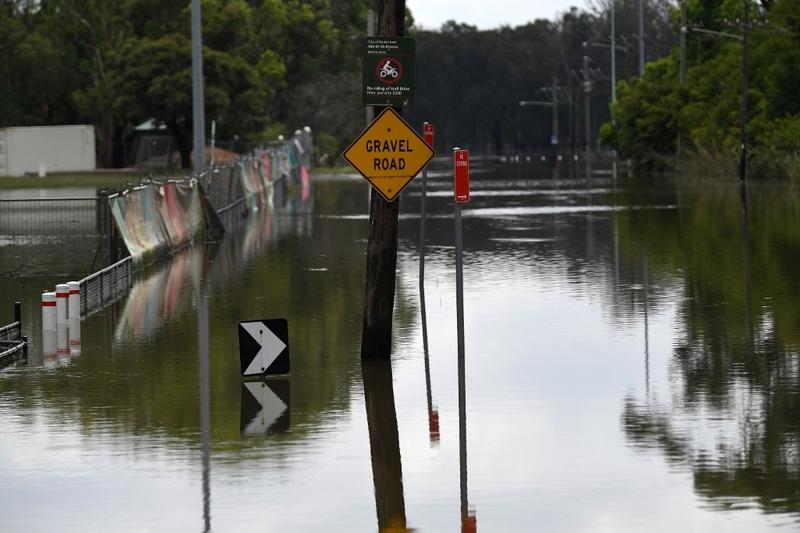 This picture taken on Feb 10, 2020 shows a general view of flooded area in Sydney. Heavy rain has given hope to Australia's drought-stricken regions, but scientists warned on Feb 11 sustained falls were needed to end a years-long dry spell. (SAEED KHAN / AFP)
This picture taken on Feb 10, 2020 shows a general view of flooded area in Sydney. Heavy rain has given hope to Australia's drought-stricken regions, but scientists warned on Feb 11 sustained falls were needed to end a years-long dry spell. (SAEED KHAN / AFP)
First it was fire, and now it is torrential rain and flooding, as residents along Australia’s eastern seaboard brace for tropical cyclone Uesi.
Having passed New Caledonia, the cyclone was expected to bring wild weather in parts of southern Queensland and northern New South Wales that are still recovering from recent severe storms and bushfires.
Large parts of NSW and southern Queensland saw the heaviest rains in more than two decades turning dry rivers into raging torrents
Residents were told to prepare for it, as emergency services continued the massive clean-up following a Feb 8-9 weekend of torrential rain and floods along much of the east coast.
Large parts of NSW and southern Queensland saw the heaviest rains in more than two decades turning dry rivers into raging torrents, forcing the evacuation of hundreds of people living in low lying areas around Sydney.
Dams feeding into Sydney’s catchment areas were full to overflowing. Sydney’s main dam Warragamba, which was at 46 percent capacity just a few weeks ago, was by Feb 11 around 60 percent full, recouping a year’s worth of water in just two days.
In central and western regions of the state, however, the story is not so rosy. Rain has been patchy, with some regions recording their first rain in years while other areas are still waiting.
Sydney experienced the heaviest torrential rainfalls since February 1990 when ex-tropical cyclone Nancy struck.
The Bureau of Meteorology said some locations along the NSW coast saw record rainfalls of between 600 and 700 millimeters.
A few weeks ago, fires were still burning along the country’s eastern seaboard in the worst bushfire season Australia has ever seen.
Last month, the bureau, in its report for 2019, said Australia had officially recorded its warmest, driest year on record.
"The key climate drivers keeping the continent very dry (are) beginning to break down," it said.
Stuart Khan, professor of civil and environmental engineering at the University of New South Wales, said there was a direct impact from the fires on “important” drinking water catchments.
He said the fires had “severely and extensively” burned major drinking water catchments for Sydney and the Shoalhaven region in NSW.
While recent rains along Australia’s eastern seaboard have extinguished fires and alleviated drought, contaminated runoff to waterways will present a new wave of challenges regarding risks to drinking water quality.
“Bushfire ash is largely composed of organic carbon, which will biodegrade in waterways, potentially leading to reduced oxygen concentrations and poor water quality,” Khan told China Daily.
“Ash also contains concentrated nutrients including nitrogen and phosphorous, which may stimulate the growth of algae and cyanobacteria in waterways.”
He said following the fires, these drinking water catchments are now in a very unstable condition and highly prone to erosion of topsoil.
“All of these impacts will challenge drinking water treatment plants and make it much more difficult to reliably produce high quality drinking water,” Khan added.
ALSO READ: In fire-hit rural Australia, climate debate burns deep
Heavy rain in parts of regional NSW recently could have relieved immediate water security issues in as many as 20 towns, James McTavish, the regional town water supply coordinator, said in a statement.
But McTavish, who was appointed to the role 12 months ago, said some towns had missed out on major falls and still faced water security problems.
McTavish has been working with about 90 regional towns that had less than 12 months of water. Some had run dry and were carting water in. Others faced running out, or serious water supply problems that would have huge economic impacts.
A spokesperson for NSW Farmers, an industry group, said the rain “has helped lifted the spirits of some drought and bushfire-stricken farming communities” in the state.
The spokesperson said that many farmers have “dusted off their gumboots” as solid rainfalls in many parts of the state have filled dams.
READ MORE: Australia receives a bittersweet fire reprieve with floods, cyclone
“While the rain has been widespread, members are reporting that it has been patchy, particularly in the Central West.
“So it’s a case of pure joy for some farmers, a welcome change in weather patterns for others, and heartache for those that missed out,” the spokesperson said.


